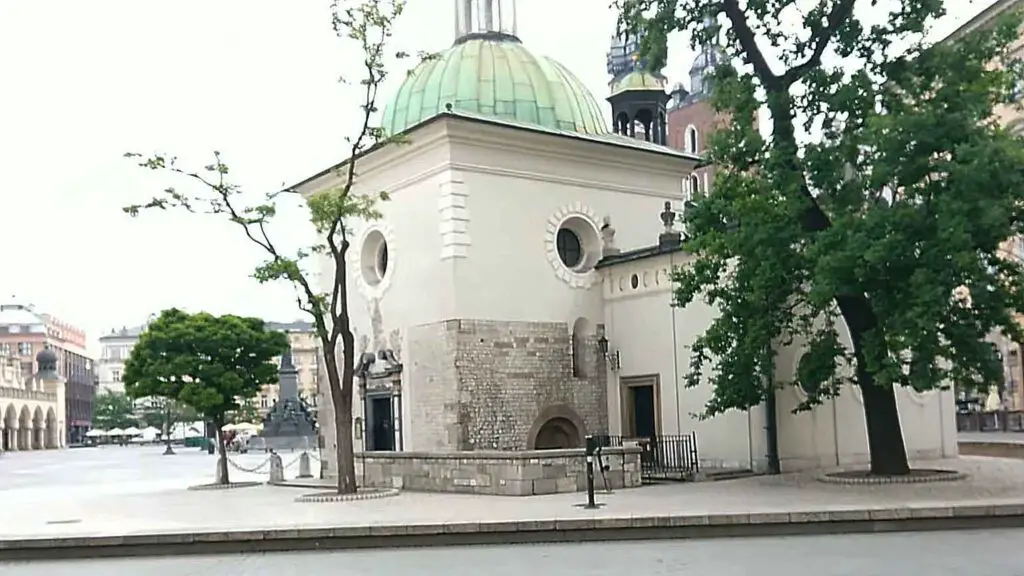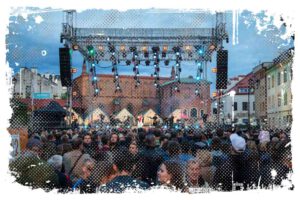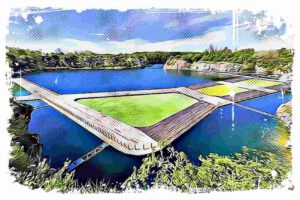If you are looking for the oldest church in Kraków, then listen do this. If you’re wandering around the market square in Krakow, chances are you’ll spot a bunch of striking buildings. Each one’s got centuries of history etched onto their walls.

You’ll pass by one petite temple, probably not thinking much of it. Let me say, it’s more than meets the eye. Amid the hustle and bustle, it’s easy to miss the remarkable secrets of the oldest church in Kraków – St. Adalbert’s, holds beneath its foundation.
Interesting Fact: St. Adalbert and St. Wojciech it is the same person
St. Adalbert’s Church, the tiniest gem on the Main Market Square, is likely the oldest church in Krakow. I think that’s quite a title to hold. It’s got a long history dating back to the time when St. Wojciech (Adalbert) and St. John Kapistran graced its steps in 1453.
- I suggest you read more about the churches in Poland in this article: How Many Churches Are There in Poland?
If you need to know, this church isn’t a parish church. It does, however, have a prestigious connection to its mother church, St. Mary’s Church, or more accurately, the Archpresbytery Church of the Assumption of the Blessed Virgin Mary.
↳ Make sure to read my guide to the most amazing places to stay in Kraków:
How to Find Best Place to Stay in Krakow Old Town – Your Guide
Inside The Oldest Church in Krakow – A Peek Into The Past

The main altar, a stunning artifact from the 1750s, houses a Baroque painting of the Mother of God with Child and the image of St. Tekla. The altar is beautifully ornamented with statues of St. Adalbert and Bishop Stanisław. One noteworthy piece is the painting of St. Adalbert by Kasper Kurcz in 1636, with scenes from the saint’s life depicted at the bottom.

Now, let’s take a trip down the timeline of this awe-inspiring church:
- 10th century – The birth of the first stone building.
- 11th-12th century – A Romanesque building emerges, with remnants like a small stone cube and a stepped portal still surviving.
- 1404 – The church becomes a university prebend, all thanks to Bishop Piotr Wysz Radoliński.
- 1453 – Jan Kapistran preaches here.
- 1611 – 1618 – The church undergoes a Baroque-style makeover under the watchful eyes of Prof. Walenty Fontana and Fr. Sebastian Milosz.
- 1711 – A new sacristy is built.
- 1758 – 1759 – Andrzej Radwański paints the interior of the nave and the dome.
- 1778 – The chapel of St. John of Nepomuk is built and the summons changes to Bl. Wincenty Kadłubek.
- 1848 – The church’s roof is damaged during a shelling of the market square by the Austrian army.
Being there, you need to know that not only the church but its underground also has a lot to offer. I can tell you that when the season allows, it’s worth digging deep into the Underground Museum of Krakow, but don’t overlook the secrets hidden beneath this ancient church. It’s an adventure you don’t want to miss.
- I think you should also read this article: Symbols of Krakow: A Look Into the Role of Coat of Arms, Flag and More
Visiting the Church – Entry Hours
Now, if you’re planning to visit this amazing church, there are a few things you need to know. For starters, it opens its doors to the faithful on weekdays from 9:00 a.m. to 5:00 p.m. during wintr, and 9:00 a.m. to 6:00 p.m. in the summer.
It’s important to note, however, that you can’t visit during the liturgy. But not to worry! On Sundays, you can pop in from 1:30 p.m. to 6:00 p.m. What’s more, if you’re looking for a place to baptize your child or maybe even tie the knot, this church is available for these sacraments.
The Exhibition in The Undergrounds

Now, let me say this. If you’re there in the summer, you’re in for a treat. There’s an exhibition titled, ’HISTORY OF THE MAIN MARKET IN KRAKÓW and the Church of St. Wojciecha’. It’s open from Monday to Friday, between 10:00 a.m. to 4:00 p.m. It’s an amazing opportunity to immerse yourself in the rich history of the place. I am convinced, you’ll find it truly fascinating.
The Patron of the Church – A Tale of Struggle and Triumph
To fully appreciate this church, you need to know about its patron, a man named Wojciech. In the 10th century, two families in Bohemia, the Přemyslids and the Sławnikowiczs, were vying for power. Wojciech, hailing from the Sławnikowiczs family, ended up as a bishop of Prague in 982. Despite his best efforts, he couldn’t resolve the family feud and sought refuge in Rome, eventually returning to Prague only when ordered by the Roman curia.
However, his peace was short-lived. He returned to Rome to excommunicate Prince Bolesław for the murder of his brothers. He was again ordered to return to Prague, but this time, he decided to take on a mission among the pagans, hoping to convert the Latin tribe. Sadly, he was met with hostility, and on April 23, 997, he was murdered while celebrating mass. Legend has it that his body was bought by the Polish prince for its weight in gold.
Unveiling the Church’s History
Built at a crossroads of trade routes, this church started its life as a simple wooden structure in the 10th century. Its location on the outskirts of a settlement centered around the Holy Trinity Church, which had been the Dominicans’ domain since 1222, gave it a unique place in the community.
Here’s a tidbit worth mentioning. The church got its name, St. Adalbert’s, from the bishop Wojciech who had preached there. I believe this adds an extra layer of historical significance to it. This was confirmed by Jan Długosz, a notable historian who immortalized the tale.
According to him, Bishop Wojciech had spent time preaching in the market square, attracting large crowds. It was his apostolate and virtuous life that left a lasting impression on the people of Krakow, so much so that they built this church in his honor.
Archaeology Unearths Ancient Architectural Features
In the scientific quest to unravel the church’s past, archaeologists have unearthed intriguing architectural remnants. These include a tower or porch on the west side of the original temple and a small Romanesque cube, along with a stepped portal. Built at the cusp of the 11th and 12th centuries, around the year 1100, the present structure replaced its wooden predecessor.
Crafted from small limestone cubes and sandstone blocks, its Romanesque walls stretch halfway up to the height of the existing structure, safeguarding a precious entry portal and a circular window.
In the eastern wall of the presbytery, one can find another Romanesque window along with two corner pilaster strips—silent witnesses to an era long past. The church was converted into a university prebend in 1404 by King Władysław Jagiełło, allowing the Krakow Academy to draw income from it. Here, in this intimate sanctuary, Saint John Kapistran gave a fiery sermon in 1453. A significant shift came in 1583 when the church started hosting services for the sizeable German minority, previously held at St. Mary’s and St. Barbara’s churches.
Transforming with the Times
The church stood undisturbed, undergoing no major architectural alterations until 1611. As the wave of new Baroque culture, originating in Rome, swept across Europe, it pushed aside the styless of the Middle Ages. Consequently, between 1611 and 1618, the church underwent a major renovation led by Walenty Fontana, a professor of the Krakow Alma Mater, and Father Sebastian Mirosz.
They elevated the walls, plastered the Romanesque stones, and crowned the structure with a dome. A new entrance was forged from the west, enshrined within a marble portal.
Later in 1711, a sacristy was added on the northern side, and in 1778, a chapel dedicated to Saint John of Nepomuk was built on the southern side. Unfortunately, the chapel was soon consumed by fire, but was promptly reconstructed in 1781 and re-dedicated to Blessed Wincenty Kadłubek. The following years only saw maintenance and restoration work. The church has since stood the test of time, largely unchanged.
Contemporary Architecture and Interior
Today, the church stands as a single-nave edifice with an elongated chancel. As you approach the market square, the black marble entrance portal, dating back to the latter half of the 18th century, greets you. The interior of the church is modestly adorned, with much of the Baroque detailing lost to renovations that revealed its Romanesque roots. Above, an elliptical dome envelops the nave, graced with contemporary polychrome by Eugeniusz Czuhorski.
The presbytery, set against a straight wall, holds an 18th-century altar featuring the image of Our Lady the Greater, a rendition of the Virgin Mary from the Roman Basilica of Santa Maria Maggiore.
Legend has it that the basilica’s establishment was divinely ordained in a vision to a Roman patrician by the Mother of God herself. She asked him to build a church where he would find snow in August.
Hence, the image is also referred to as Our Lady of the Snows—an enduring testament to the mysteries and miracles that intertwine the church’s rich past with its present.
The Sacred Art of the Church
At the dawn of the 17th century, precisely in 1621, Marcin Szyszkowski, the Bishop of Kraków, issued a decree regarding religious art. It was mandated in this edict that depictions of the Mother of God should derive inspiration from sources like the Roman Madonna or the native Black Madonna from Częstochowa.
- I think it’s worth reading this article too: Religion and Church in Poland Before and During World War II
Bordering the altar are effigies of two Polish saints and bishops: Wojciech and Stanisław. The Baroque altar was once adorned with a painting attributed to Kasper Kurcz, representing the church’s patron. However, due to restorative endeavors, it now graces the wall of the nave.
Spanning the rood arch in front of the presbytery hangs a 15th-century crucifix. In the nave corners, where you would traditionally expect a crucifixion group, figures of angels have been installed on consoles.
Venturing into the Baroque Chapel
From the south, we enter the Baroque chapel dedicated to the blessed chronicler, Wincenty Kadłubek. This chapel holds the unique distinction of being the only place in Krakow under his patronage.

While his relics lie in the cathedral, within Saint Thomas of Kantuary’s chapel, this humble chapel pays tribute with its barrel vault adorned with lunettes and a simple altar. The altar features a painting of the chronicler, likely the work of Szymon Czechowicz. The original altar has since been relocated to Saint Margaret’s chapel in Salwator.
A Trip Back in Time
As we exit the church from the southern side, stone stairs lead us down towards the Romanesque portal, signifying the original level of the Krakow market—over two meters lower than today’s level. Here lies an archaeological reserve, a veritable journey back in time that showcases the building’s relics, layers of the market ground, and the church’s history. This exhibition, offering a unique glimpse into the past, opens its doors during the four spring and summer months each year.
References
- https://pl.wikipedia.org/wiki/Ko%C5%9Bci%C3%B3%C5%82_%C5%9Bw.Wojciecha_w_Krakowie(Rynek_G%C5%82%C3%B3wny)
- https://pl.wikipedia.org/wiki/Wojciech_S%C5%82awnikowic




